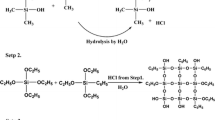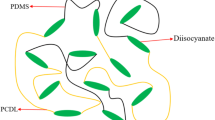Abstract
Novel heat-resistant coating materials with excellent adhesion properties were prepared by modification of polysiloxane resin (PSil) with a pre-synthesized tailored polyurethane/polyurea copolymer end-capped with siloxane (PU). The modification was achieved by crosslinking the hydroxyl group of PSil and ethoxy group of PU in the presence of di-n-butyltin dilaurate. The chemical structure of PU was analyzed by Fourier Transform Infrared and Hydrogen-1 Nuclear Magnetic Resonance spectroscopic methods. A series of modified silicone resins (MSRs) have been synthesized and investigated. The molecular weights of the resins were determined by means of gel permeation chromatography. The morphology of the MSR studied by scanning electron microscopy has shown that the resin containing 30% of PU has a small particle size and a good particle size distribution. The adhesion and the mechanical properties of the resins containing 20, 30, and 40% of PU have shown a good performance. Using thermogravimetric analysis, the thermal properties and the thermal degradation of the MSR were investigated.











Similar content being viewed by others
References
Jiang, H, Zheng, Z, Song, W, Wang, X, “Moisture-Cured Polyurethane/Polysiloxane Copolymers: Effect of the Structure of Polyester Diol and NCO/OH Ratio.” J. Appl. Polym. Sci., 108 (6) 3644–3651 (2008)
Yilgor, E, Yilgor, I, “Hydrogen Bonding: A Critical Parameter in Designing Silicone Copolymers.” Polymer, 42 (19) 7953–7959 (2001)
Sobolevsky, MV, Oligoorganosiloxanes: Properties, Obtaining and Applications. Khimiya, Moscow, 1985
Fichet, O, Vidal, F, Darras, V, Boileau, S, Teyssié, D, “Polysiloxane Based Interpenetrating Polymer Network: Synthesis and Properties.” In: Boileau, S, Boury, B, Ganachaud, F (eds.) Silicon Based Polymers—Advances in Syntheses and Supramolecular Organization, pp. 19–28. Springer, London, 2008
Witucki, GL, “The Evolution of Silicon-Based Technology in Coating.” Dow Corning Corporation, 26 1202–1208 (2003)
Leir, CM, “Telechelic Siloxanes with Hydrogen-Bonded Polymerizable End Groups. I. Liquid Rubbers and Elastomers.” J. Appl. Polym. Sci., 117 (2) 656–756 (2010)
Ionescu, M, Chemistry and Technology of Polyols for Polyurethanes. Rapra Technology Ltd, Shawbury, 2005
Prado, LASA, Sforça, ML, de Oliveira, AG, Yoshida, IVP, “Poly(dimethylsilane) Network Modified with Poly(phenylsilsesquioxanes): Synthesis, Structural Characterization and Evaluation of Thermal Stability and Permeability.” Eur. Polym. J., 44 3080–3086 (2008)
Ni, H, Simonsick, WJ, Jr, Skaja, AD, Williams, JP, Soucek, MD, “Polyurea/Polysiloxane Ceramer Coatings.” Prog. Org. Coat., 88 (2) 97–110 (2000)
Zhang, C, Zhang, X, Dai, J, Bai, C, “Synthesis and Properties of PDMS Modified Waterborne Polyurethane–Acrylic Hybrid Emulsion by Solvent-Free Method.” Prog. Org. Coat., 63 (2) 238–244 (2008)
Vlad, S, Vlad, A, Oprea, S, “Interpenetrating Polymer Networks Based on Polyurethane and Polysiloxane.” Eur. Polym. J., 38 829–835 (2002)
Hill, DJT, Killeen, MI, O’Donnell, JH, Pomery, JP, “Development of Wear-Resistant Thermoplastic Polyurethanes by Blending with Poly(dimethyl siloxane). I. Physical Properties.” J. Appl. Polym. Sci., 61 (10) 1757–1766 (1996)
Bremner, T, Hill, DJT, Killeen, MI, O’Donnell, JH, Pomery, PJ, “Development of Wear-Resistant Thermoplastic Polyurethanes by Blending with Poly(dimethyl siloxane). II. A Packing Model.” J. Appl. Polym. Sci., 65 (5) 939–950 (1997)
Lucas, PL, Robin, JJ, “Silicone-Based Polymer Blends: An Overview of Materials and Processes.” Adv. Polym. Sci., 209 111–147 (2007)
Belorgey, G, Sauvet, G, “Organosiloxane Block and Graft Copolymers.” In: Jones, RG, Ando, W, Chojnowski, J (eds.) Silicon Coating Polymers, pp. 44–78. Kluwer, The Netherlands, 2000
Wagner, M, Wolf, BA, “Effect of Block Copolymer on the Interfacial Tension Between Two ‘Immiscible’ Homopolymers.” Polymer, 34 (7) 1460–1464 (1993)
Khandpur, AK, Guegan, P, Macosko, CW, “Compatibilizers for A/B Blends: A-C-B Triblock Versus A-B Diblock Copolymers.” SPE Regional Technical Conference on Polymer Alloys and Blends, Polyblends’95, pp. 88–96, Quebec, October 1995
Fleischer, CA, Morales, AR, Koberstein, JT, “Interfacial Modification Through End Group Complexation in Polymer Blends.” Macromolecules, 27 (2) 379–385 (1994)
Hamurcu, EE, Baysal, BM, “Interpenetrating Polymer Networks of Poly(dimethylsiloxane): 1. Preparation and Characterization.” Polymer, 34 (24) 5163–5167 (1993)
Turner, J, Cheng, YL, “Process for Preparing Interpenetrating Polymer Networks of Controlled Morphology.” US Patent 6,331,578, 2001
He X, Herz, JE, Mayer, G, Vidmaier, JM, “Preparation of Interpenetrating Acrylic Polymer-Siloxane Networks.” US Patent 5,424,375, 1995
Ebdon, JR, Hourston, DJ, Klein, PG, “Polyurethane–Polysiloxane Interpenetrating Polymer Networks. A Polyether Urethane-Poly(dimethylsiloxane) System.” Polymer, 25 (11) 1079–1085 (1984)
Zhou, P, Xu, Q, Frisch, HL, “Kinetics of Simultaneous Interpenetrating Polymer Networks of Poly(dimethylsiloxane-urethane) Poly(methyl methacrylate) Formation and Studies of Their Phase Morphology.” Macromolecules, 27 (4) 938–946 (1994)
Bilgrien, CJ, Lee, CL, Mullan, SP, Reese, HH, “Storage-Stable Flowable Organosiloxane Composition Powders and Their Preparation.” US Patent 5,153,238, 1992
Fujiki, M, Furuta, D, Naito, M, “Manufacture of Semi-IPN (Interpenetrating Polymer Network) Composite and the Composite Made of Crosslinkable Siloxane and Radically Polymerized Polymer.” Japan Patent 4263062, 2004
Gilmer, TC, Hall, PK, Ehrenfeld, H, Wilson, K, Bivens, T, Clay, D, Endresz, C, “Synthesis, Characterization and Mechanical Properties of PMMA/Poly(aromatic/aliphatic siloxane) Semi-Interpenetrating Polymer Network.” J. Polym. Sci., 34 (6) 1025–1077 (1996)
Knaub, P, Camberlin, Y, Gérard, JF, “New Reactive Polymer Blends Based on Poly(urethanes-ureas) (PUR) and Polydisperse Polydimethylsiloxane (PDMS): Control of Morphology Using a PUR-b-PDMS Block Copolymer.” Polymer, 29 (8) 1365–1377 (1988)
Gross, C, Lee, M, Liao, J, “Thermoplastic Silicone Elastomers from Compatibilized Polyester Resins.” WO Patent 2,003,035,764, 2003
Kahraman, MV, Kugu, M, Menceloglu, Y, Kayaman-Apohan, N, Gungor, A, “The Novel Use of Organo Alkoxy Silane for the Synthesis of Organic–Inorganic Hybrid Coatings.” J. Non-Cryst. Solids, 352 2143–2151 (2006)
Phillip, G, Schmidt, H, “New Materials for Contact Lenses Prepared from Si- and Ti-Alkoxides by the Sol–Gel Process.” J. Non-Cryst. Solids, 63 283–292 (1984)
Chou, TP, Chandrasekeran, C, Limmer, SJ, Seraji, S, Wu, Y, Forbeu, MJ, Nguyen, C, Cao, GZ, “Organic–Inorganic Hybrids Coatings for Corrosion Protection.” J. Non-Cryst. Solids, 290 153–162 (2001)
Chiang, CL, Ma, CCM, “Synthesis, Characterization and Thermal Properties of Novel Epoxy Containing Silicon and Phosphorus Nanocomposites by Sol–Gel Method.” Eur. Polym. J., 38 (11) 2219–2224 (2002)
Brinker, CJ, Scherer, GW, Sol–Gel Science: The Physics and Chemistry of Sol–Gel Processing. Academic Press Inc., San Diego, 1990
Pierre, AC, Introduction to Sol–Gel Processing. Kluwer, Boston, 1998
Wang, L, Shen, Y, Lai, X, Li, Z, Liu, M, “Synthesis and Properties of Cross-linked Waterborne Polyurethane.” J. Polym. Res., 18 (3) 469–476 (2010)
Sheth, JP, Aneja, A, Wilkes, GL, Yilgor, E, Atilla, GE, Yilgor, I, Beyer, FL, “Influence of System Variables on the Morphological and Dynamic Mechanical Behavior of Polydimethylsiloxane Based Segmented Polyurethane and Polyurea Copolymers: A Comparative Perspective.” Polymer, 45 (20) 6919–6932 (2004)
Shea, KJ, Loy, DA, “Bridged Polysilsesquioxanes. Molecular-Engineering Hybrid Organic–Inorganic Materials.” Chem. Mater., 13 (10) 3306–3319 (2001)
Chattopadhyay, DK, Raju, KVSN, “Structural Engineering of Polyurethane Coating for High Performance Applications.” Prog. Polym. Sci., 32 (3) 352–418 (2007)
Thurn, F, Wolff, S, “Neue Organosilane für die Reifenindustrie.” Kautsch. Gummi Kunstst., 28 733–739 (1975)
Mazurek, MH, “Silicones.” In: Crabtree, RH, MIngos, DMP (eds.) Comprehensive. Organometallic Chemistry, vol. 3, pp. 651–697. Elsevier, Amsterdam, 2007
Jia, M, Wu, C, Li, W, Gao, D, “Synthesis and Characterization of Silicon Resin with Silphenylene Units in Si–O–Si Backbones.” J. Appl. Polym. Sci., 114 (2) 971–977 (2009)
Drinberg, AS, Ytsko, EF, Kalinskaya, TV, Anti-Corrosion Primers. Niproins LKM, Saint-Petersburg, 2006 (in Russian)
Brandrup, J, Immergut, EH, The Polymer Handbook, 3rd ed. John Wiley and Sons, New York, 1989
Rosen, SL, Fundamental Principle of Polymeric Materials, 2nd ed. Wiley, New York, 1993
Luo, YJ, Gui, HX, Silicone Resins and Their Applications. Chemical Industry Press, Beijing, 2001
Krol, P, Linear Polyurethanes: Synthesis methods, Chemical Structures. Properties and Applications, Leiden-Boston, 2008
Tarutina, LI, Pozdnyakova, FO, Spectral Analysis of Polymers. Khimya, Leningrad, 1986
Mistry, BD, A Handbook of Spectroscopic Data—Chemistry (UV, IR, PRM, 13CNMR and Mass Spectroscopy). Company OB, Jaipur, India, 2009
Belenky, BG, Vilenchik, LZ, Chromatography of Polymers. Khimya, Moscow, 1978
Korshak, VV, Thermal Resistant Polymers. Nauka, Moscow (1969)
Nguyen, D, Chambon, P, Rosselgong, J, Cloutet, E, Gramail, H, Ravaine, S, “Simple Route to Get Very Hydrophobic Surfaces of Fibrous Materials with Core–Shell Latex Particles.” J. Appl. Polym. Sci., 108 (5) 2772–2777 (2008)
Hillmyer, MA, Lodge, TP, “Synthesis and Self-assembly of Fluorinated Block Copolymers.” J. Polym. Sci., 40 (1) 1–8 (2002)
Jenekhe, SA, Chen, XL, “Self-assembly of Ordered Microporous Materials from Rod-Coil Block Copolymers.” Science, 283 372–375 (1999)
Olsen, BD, Segalman, RA, “Self-assembly of Rod-Coil Block Copolymers.” Mater. Sci. Eng. R: Reports, 62 (2) 37–66 (2008)
Luzinov, I, Minko, S, Tsukruk, VV, “Adaptive and Responsive Surfaces Through Controlled Reorganization of Interfacial Polymer Layers.” Prog. Polym. Sci., 29 635–698 (2004)
Joki-Korpela, F, Pakkaren, TT, “Incorporation of Polydimethylsiloxane into Polyurethanes and Characterization of Copolymers.” Eur. Polym. J., 47 1694–1708 (2011)
De, PP, Roy, NC, Dutta, NK, Thermal Analysis of Rubbers and Rubbery Materials. Rapra Technology Ltd, Shawbury, 2010
Pielichowski, K, Njuguna, J, Thermal Degradation of Polymer Materials. Rapra Technology Ltd, Shawbury, 2005
Pielichowski, K, Janowski, B, “Semi-Inter Penetrating Polymer Networks of Polyurethane and Poly(vinyl Chloride). Thermal Stability Assessment.” J. Therm. Anal. Cal., 80 147–151 (2005)
Chuang, F-S, Tsia, H-Y, Chow, J-D, Tsen, W-C, Shu, Y-C, Jang, S-C, “Thermal Degradation of Poly(siloxane-urethane) Copolymers.” Polym. Degrad. Stab., 93 1753–17761 (2008)
Author information
Authors and Affiliations
Corresponding author
Rights and permissions
About this article
Cite this article
Mikhailova, A.M., Tamboura, M. & Jia, M.Q. Synthesis, characterization, and analyses of mechanical, adhesion, and thermal properties of polysiloxane resin modified with segmented polyurethane. J Coat Technol Res 10, 97–108 (2013). https://doi.org/10.1007/s11998-012-9424-8
Published:
Issue Date:
DOI: https://doi.org/10.1007/s11998-012-9424-8




